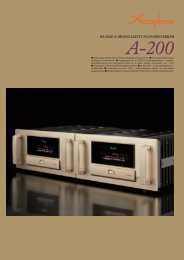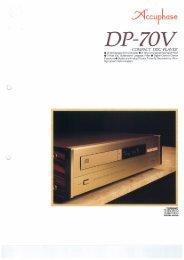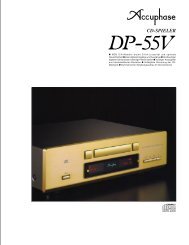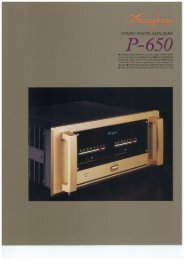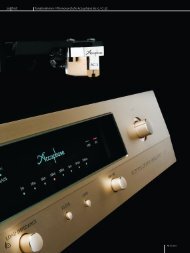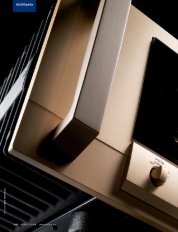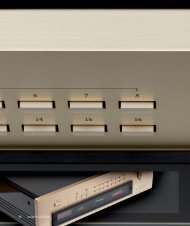C-2400 - Accuphase
C-2400 - Accuphase
C-2400 - Accuphase
Create successful ePaper yourself
Turn your PDF publications into a flip-book with our unique Google optimized e-Paper software.
m Revolutionary AAVA volume control for top performance and superb<br />
sound quality m Fully modular construction with individual left/right<br />
amplifier units arranged on motherboard m Separate power<br />
transformers and filtering capacitors for left and right channels<br />
m Logic-controlled relays for shortest signal paths m High quality<br />
tone controls m Optional analog record playback capability
Innovative AAVA type volume control guarantees great sound and top<br />
performance Experience volume adjustment without deterioration in<br />
S/N ratio or distortion. AAVA and other circuit modules are arranged on<br />
motherboard separately for left and right channels. Fully dual monaural<br />
construction features two separate power transformers. Dedicated phono<br />
equalizer unit allows analog record reproduction with superb fidelity.<br />
The C-<strong>2400</strong> inherits the design technology of the<br />
outstanding <strong>Accuphase</strong> C-2800, featuring the<br />
same AAVA type volume control. One of the most<br />
important aspects of a preamplifier is how it<br />
handles volume adjustment. AAVA (<strong>Accuphase</strong><br />
Analog Vari-gain Amplifier) is an innovative<br />
concept that differs radically from conventional<br />
variable-resistor type volume controls.<br />
Amplification and volume control are fully unified,<br />
eliminating all mechanical contact points. Pure<br />
analog processing ensures optimum<br />
performance and superb sound. Doing away with<br />
the variable resistor in the signal path has<br />
numerous advantages and brings the amplifier<br />
a significant step closer to absolute purity in<br />
signal transmission. Another benefit of AAVA is<br />
that it is configured only with highly reliable<br />
semiconductor components. This assures that<br />
performance and sound quality will remain<br />
undiminished for many years to come. The large<br />
volume knob on the front panel employs a<br />
position detection method that combines superb<br />
precision with a smooth conventional feel.<br />
The power transformer, filtering capacitors and<br />
all other parts of the power supply are duplicated<br />
for the left and right channel. What's more, all<br />
unit amplifiers such as for line input, balanced<br />
output, and AAVA are also entirely separate for<br />
the two channels, arranged on a high-quality<br />
motherboard. This fully monaural construction<br />
prevents unwanted interaction both on the<br />
electrical and the physical plane.<br />
The line amplifier with integrated volume control<br />
is a major aspect of the C-<strong>2400</strong>, but there are<br />
also a host of other attractive features in this<br />
superb analog preamplifier. Tone controls and<br />
loudness compensator allow fine tuning of the<br />
sound. Tape recorder and copying facilities as<br />
well as an EXT PRE function provide connection<br />
flexibility. A phono equalizer unit (AD-2800) for<br />
faithful playback of analog records is also<br />
available.<br />
AAVA (<strong>Accuphase</strong> Analog Vari-gain Amplifier) volume control<br />
The newly developed volume control called AAVA (<strong>Accuphase</strong> Analog Vari-gain Amplifier) is totally different from conventional controls using<br />
resistors. Because the music signal does not pass through variable resistors, it is not affected by changes in impedance. This means that high<br />
signal-to-noise ratio and low distortion of the signal are maintained. The volume can be adjusted without any deterioration in sound quality.<br />
n AAVA resolution<br />
AAVA adjusts the listening volume by means of 16 current<br />
switches which are operated by 16 weighted V-I converter<br />
amplifiers. The number of possible volume steps set by the<br />
combination of these converter amplifiers is 2 to the power<br />
of 16 = 65,536.<br />
16 current switches<br />
(65,536 possible combinations)<br />
AAVA operation principle<br />
n AAVA maintains high S/N ratio<br />
With conventional volume controls, the impedance<br />
increases significantly at settings that correspond to normal<br />
listening levels, thereby leading to increased noise. Because<br />
AAVA performs adjustment by selective use of V-I converter<br />
amplifiers (changing the actual gain), there is no change in<br />
impedance and thus no deterioration of S/N ratio. Changing<br />
the volume with AAVA does not mean introducing noise or<br />
detracting from the high performance of the amplifier.<br />
BUFFER<br />
INPUT<br />
BUFFER<br />
Input music signal<br />
Current<br />
values<br />
are<br />
added<br />
I-V Converter<br />
Reconversion of current into<br />
voltage<br />
GAIN<br />
OUTPUT<br />
n No more left/right tracking differences or<br />
crosstalk<br />
Because AAVA is an electronic circuit employing highly<br />
precise metal film resistors, there is virtually no left/right<br />
tracking error also at low volume levels. Since channels<br />
can be kept separate, crosstalk also does not present a<br />
problem.<br />
n Simple circuit configuration<br />
AAVA unifies the amplifier and volume control functions,<br />
resulting in a circuit that is electrically very simple. Longterm<br />
reliability is excellent, with performance and sound<br />
quality that will remain unchanged also after prolonged use.<br />
n AAVA means analog processing<br />
The AAVA circuit converts the music signal from a voltage<br />
into a current, switches gain by means of current switches,<br />
and then reconverts the current into a voltage. The entire<br />
process is carried out in the analog domain.<br />
n Same operation feel as a conventional highquality<br />
volume control<br />
The volume control knob position is detected by a dedicated<br />
CPU which in turn selects the current switches for AAVA<br />
operation. Operating the knob therefore feels exactly the<br />
same as with a conventional control, and as before,<br />
operation via the remote commander is also possible.<br />
n Attenuator and balance control also<br />
implemented by AAVA<br />
The functions of the attenuator and the left/right balance<br />
control are covered by the AAVA circuit as well, eliminating<br />
the need for additional circuit stages. Keeping the<br />
configuration simple helps to maintain high performance<br />
and sonic purity.<br />
V- I Converter CPU<br />
Conversion into current with 16<br />
weighting stages (1/2 - 1/2 16 )<br />
Volume<br />
Balance<br />
Attenuator<br />
CPU detects position of volume knob<br />
and operates current on/off switches<br />
according to knob position<br />
VOLUME<br />
5<br />
4 6<br />
3 7<br />
2 8<br />
1 9<br />
MIN<br />
MAX<br />
Volume knob is turned and<br />
position is detected<br />
AAVA operation principle<br />
AAVA operates by feeding the music signal to a V-I (voltage - current) converting amplifier<br />
where it is weighted in 16 steps [1/2, 1/2 2 , ... 1/2 15 , 1/2 16 ]. The 16 current steps are turned on or<br />
off by 16 current switches, and the combination of switch settings determines the overall volume.<br />
The switching operation is controlled by a CPU according to the position of the volume control<br />
knob. The combined signal current forms a variable gain circuit that adjusts volume. Finally, the<br />
combined current is converted back into a voltage by an I-V (current - voltage) converter.<br />
Input buffer, 16 V-I converter<br />
amps and current switches,<br />
current adder, I-V converter<br />
amp, and other circuitry on<br />
modular AAVA unit, installed<br />
separately for left/right<br />
channel on motherboard
n Supplied remote commander<br />
RC-32<br />
Allows volume control and input<br />
source selection.<br />
Selectable preamplifier gain<br />
The overall gain of the preamplifier<br />
can be set to 12, 18, or 24 dB with<br />
a rear-panel switch. This allows the<br />
C-<strong>2400</strong> to operate at optimum gain<br />
in any kind of system.<br />
Factory default: 18 dB<br />
Logic-controlled relays assure high sound<br />
quality and long-term reliability<br />
The C-<strong>2400</strong> offers a host of input and output<br />
connectors and functions. Strategically placed<br />
relays prevent any signal degradation that could<br />
occur if the signal has to travel through long paths<br />
for connection and function switching.<br />
Fully dual monaural construction with<br />
separate power transformers and separate<br />
board-mounted unit amplifiers for left/right<br />
The input buffer, AAVA circuit, balanced output<br />
and other amplifier circuitry are configured as<br />
five separate units for each channel, arranged<br />
neatly on a motherboard. Power transformers and<br />
smoothing capacitors<br />
are also separate for the two<br />
stereo channels. This dual monaural<br />
approach assures total freedom from unwanted<br />
mutual interaction.<br />
Tone controls use summing active filters for<br />
highest sound quality<br />
The tone control circuitry in the C-<strong>2400</strong> uses<br />
summing active filters. The illustration below<br />
shows the operation principle of this circuit. The<br />
flat signal is passed straight through, and only<br />
when an adjustment is required, the<br />
characteristics are created at F1 and F2 and<br />
added to<br />
the signal,<br />
Input<br />
Output<br />
thereby<br />
producing<br />
F1<br />
the desired<br />
VR1<br />
change.<br />
This design<br />
F2<br />
provides<br />
VR2<br />
efficient<br />
Principle of tone control circuitry<br />
control<br />
(summing active filter)<br />
without<br />
degrading signal purity.<br />
n Flexible input/output configuration<br />
n Dedicated headphone amplifier<br />
optimized for sound quality<br />
n EXT PRE function allows use of<br />
external preamplifier<br />
n Optional phono equalizer allows<br />
playback of analog records<br />
n Supplied remote commander with<br />
volume control function<br />
n Versatile features:<br />
m Recording/playback/monitoring facilities<br />
for 2 recorders<br />
m Copy function<br />
m Loudness compensator for fuller bass at<br />
low levels<br />
m Subsonic filter removes ultra low<br />
frequency noise<br />
m Phase selector<br />
m Attenuator
Dedicated Phono Equalizer Unit AD-2800<br />
Analog records can be reproduced by installing the dedicated phono equalizer unit AD-2800 in a rearpanel<br />
slot. The AD-2800 uses printed circuit boards made from Teflon material (glass fluorocarbon resin)<br />
and is housed in a sturdy aluminum case for complete protection against any external interference. Shortest<br />
possible connection between inputs and amplifier circuitry assures outstanding S/N ratio. Highly reliable<br />
DIN connectors are used for connection to main unit.<br />
+ B<br />
Q13<br />
Q 17<br />
Q 3<br />
Q11<br />
Q19<br />
Input<br />
Q 5<br />
Q 7<br />
Q9<br />
Q 4<br />
Q 1<br />
MM Q 6 Q 8 Q10<br />
Q 2<br />
MM<br />
MC<br />
Q12<br />
MC<br />
Q14<br />
Q15<br />
Q16<br />
Q18<br />
Q20<br />
– B<br />
Output<br />
MM<br />
MC<br />
Gain:<br />
30/36 dB, switchable<br />
Input impedance: 47 kilohms<br />
Gain:<br />
62/68 dB, switchable<br />
Input impedance: 10/30/100 ohms, switchable<br />
Circuit diagram of phono equalizer<br />
unit AD-2800 (one channel)<br />
Equalizer<br />
elements<br />
DC servo amplifier<br />
AD-2800<br />
✽ The phono equalizer units AD-290 and AD-290V designed for<br />
the <strong>Accuphase</strong> models C-290 and C-290V can also be used in<br />
the C-<strong>2400</strong>.<br />
✽ The AD-2800 can also be used in the <strong>Accuphase</strong> models<br />
C-2800, C-290 and C-290V.<br />
n Front panel<br />
n Rear panel<br />
Expansion slot<br />
for AD-2800<br />
Push to open<br />
sub panel<br />
C-<strong>2400</strong> Guaranteed Specifications<br />
[Guaranteed specifications are measured according to EIA standard RS-490. AD stands for<br />
“Analog Disc”.] [Specifications are shown for phono equalizer unit AD-2800 installed.]<br />
m Frequency Response BALANCED/UNBALANCED INPUT: 03 - 200,000 Hz +0 –3.0 dB<br />
20 - 020,000 Hz +0, –0.2 dB<br />
AD INPUT [MM/36 dB, MC]: 20 - 020,000 Hz ±0.2 dB<br />
AD INPUT [MM/30 dB]: 20 - 020,000 Hz ±0.3 dB<br />
m Total Harmonic Distortion (for all inputs) 0.005%<br />
m Input Sensitivity, Input Impedance<br />
Input<br />
Sensitivity<br />
For rated output For 0.5 V output<br />
Input impedance<br />
AD:MM/30 dB INPUT 8.0 mV 2.0 mV 47 kΩ<br />
AD:MM/36 dB INPUT 4.0 mV 1.0 mV 47 kΩ<br />
AD:MC/62 dB INPUT 0.2 mV 0.05 mV 10/30/100 Ω, switchable<br />
AD:MC/68 dB INPUT 0.1 mV 0.025 mV 10/30/100 Ω, switchable<br />
BALANCED/UNBALANCED 252 mV 63 mV 40 kΩ/20 kΩ<br />
m Rated Output Voltage, BALANCED/UNBALANCED OUTPUT: 2 V 50 ohms<br />
Output Impedance REC (with AD input): 252 mV 200 ohms<br />
m S/N Ratio<br />
Input terminal<br />
Input shorted, IHF-A weighting<br />
S/N ratio at rated output<br />
S/N ratio (EIA)<br />
AD:MM/30 dB INPUT 95 dB 91 dB<br />
AD:MM/36 dB INPUT 89 dB 92 dB<br />
AD:MC/62 dB INPUT 80 dB 87.5 dB<br />
AD:MC/68 dB INPUT 75 dB 88.5 dB<br />
BALANCED/UNBALANCED 111 dB 108 dB<br />
A Input selector<br />
B Function LED indicator<br />
C Volume control<br />
D Power switch<br />
E Output selector<br />
EXT PRE ALL BAL UNBAL OFF<br />
F Bass/Treble controls<br />
G Tone control on/off button<br />
H Phase selector button<br />
I Stereo/mono selector<br />
J Copy button<br />
K Subsonic filter<br />
L MC cartridge load impedance selector<br />
M Equalizer gain selector<br />
MM: 30 dB/36 dB MC: 62 dB/68 dB<br />
N Recorder switch<br />
O Balance control<br />
P Headphone jack<br />
Q Loudness compensator<br />
R Attenuator<br />
S Line input connectors TUNER CD LINE 1, 2, 3<br />
T Recorder output/input connectors<br />
U21<br />
Unbalanced output connectors<br />
U22<br />
External preamplifier input connectors (unbalanced)<br />
U23<br />
Gain selector 24 dB 18 dB 12 dB<br />
U24<br />
CD/LINE balanced input connectors<br />
a Ground b Inverted (–) c Non-inverted (+)<br />
U25<br />
Balanced output connectors<br />
U26<br />
External preamplifier input connectors (balanced)<br />
U27<br />
AC inlet H<br />
Remarks<br />
H This product is available in versions for 120/230 V AC. Make sure that the voltage shown on<br />
the rear panel matches the AC line voltage in your area.<br />
H The shape of the AC inlet and plug of the supplied power cord depends on the voltage rating<br />
and destination country.<br />
H<br />
m Maximum Output Level BALANCED/UNBALANCED OUTPUT: 7.0 V<br />
REC (with AD input):<br />
6.0 V<br />
m LINE Maximum Input Level BALANCED/UNBALANCED INPUT: 6.0 V<br />
m Maximum AD Input Level MM [30/36dB] INPUT: 300/150 mV<br />
(1 kHz, 0.005% THD) MC [62/68dB] INPUT: 7.5/3.75 mV<br />
m Minimum Load Impedance BALANCED/UNBALANCED OUTPUT: 600 ohms<br />
REC:<br />
010 kilohms<br />
m Gain (gain selector: 18 dB)<br />
* Gain can be set to 12/18/24 dB<br />
BALANCED/UNBALANCED INPUT ➞ BALANCED/UNBALANCED OUTPUT: 18 dB<br />
UNBALANCED INPUT ➞ REC OUTPUT: 0 dB<br />
AD (MM 30/36dB) INPUT ➞ BALANCED/UNBALANCED OUTPUT: 48/54 dB<br />
AD (MM 30/36dB) INPUT ➞ REC OUTPUT:<br />
30/36 dB<br />
AD (MC 62/68dB) INPUT ➞ BALANCED/UNBALANCED OUTPUT: 80/86 dB<br />
AD (MC 62/68dB) INPUT ➞ REC OUTPUT:<br />
62/68 dB<br />
m Tone Controls<br />
Turnover frequency and adjustment range<br />
BASS: 300 Hz ±10 dB (50 Hz)<br />
TREBLE: 3 kHz ±10 dB (20 kHz)<br />
m Loudness Compensation +6 dB (100 Hz)<br />
m Subsonic Filter<br />
10 Hz: –18 dB/octave<br />
m Attenuator<br />
–20 dB<br />
m Power Requirements AC 120 V / 230 V, 50/60 Hz (Voltage as indicated on rear panel)<br />
m Power Consumption 33 watts<br />
m Maximum Dimensions Width 465 mm (18-3/8”)<br />
Height 150 mm (5-7/8”)<br />
Depth 403 mm (15-7/8”)<br />
(Depth with AD-2800 installed: 412 mm)<br />
m Weight<br />
17.6 kg (38.8 lbs) net (18.5 kg with AD installed)<br />
23.0 kg (50.7 lbs) in shipping carton<br />
n Supplied accessories:<br />
m AC power cord<br />
m Audio cable with plugs (1 m)<br />
m Remote commander RC-32<br />
• Specifications and design subject to change without notice for improvements.<br />
http://www.accuphase.com/<br />
G0305Y<br />
PRINTED IN JAPAN 851-0133-00 (AD1)





